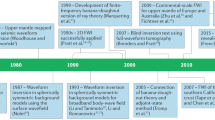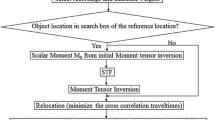Abstract
A new inversion algorithm for simultaneously reconstructing the slip vectors and rupture times of a propagating finite fault is developed based on the recent progress in the nonlinear programming study. To check the validity of this new inversion algorithm, several numerical tests are conducted. The results show that this new source rupture process inversion algorithm is computationally efficient and numerically stable, and depends less on the initial model compared with the two popular inversion methods, i.e. the linear matrix method and the global stochastic search method. Therefore, this new inversion algorithm is expected to be useful in inverting earthquake rupture processes.
Similar content being viewed by others
References
Hartzell, S. H., Heaton, T. H., Inversion of strong ground motion and teleseismic waveform data for the fault rupture history of the 1979 Imperial Valley, California earthquake, Bull. Seism. Soc. Am., 1983,73: 1553–1583.
Wald, D., Heaton, T., Spatial and temporal distribution of slip for the 1992 Landers, California earthquake, Bull. Seism. Soc. Am., 1994, 84: 668–691.
Chen, Y. T., Xu, L. S., Li, X. et al., Source process of the 1990 Gonghe, China, earthquake and tectonic stress field in the northeastern Qinghai-Xizang (Tibetan) plateau, PAGEOPH, 1996, 146: 697–715.
Nakayama, W., Minoru, T., Slip history of the 1994 Sanriku-Haruka-Oki, Japan, earthquake deduced from strong motion data, Bull. Seism. Soc. Am., 1997, 87(4): 918–931.
Beroza, G. C., Linearized inversion for fault rupture behavior: Application to the 1984 Morgan Hill, California, earthquake, J. Geophys. Res., 1988, 93(B6): 6275–6296.
Das, S., Aki, K., Fault plane with barriers: A versatile earthquake model, J. Geophys. Res., 1977, 82(B7): 5658–5670.
Aki, K., Asperities, barriers, characteristic earthquakes and strong motion prediction, J. Geophys. Res., 1984, 89(B7): 5867–5872.
Aki, K., Richards, P. G., Quantitative Seismology Theory and Methods, San Francisco: W. H. Freeman, 1980.
Fukuyama, E., Mikumo, T., Dynamic rupture analysis: Inversion for the source process of the 1999 Izu-Oshima, Japan, earthquake (M = 6.5),J. Geophys. Res., 1993, 98(B4): 6529–6542.
Hartzell, S., Liu, P. C., Calculation of earthquake rupture histories using a hybrid global search algorithm: Application to the 1992 Landers, California, earthquake, Phys. Earth Planet Inter., 1996, 95: 79–99.
Zeng, Y., Anderson, J. G., A composite source modeling of the 1994 Northridge earthquake using genetic algorithm, Bull. Seism. Soc. Am., 1996, 86(1B): S71–83.
Liu, P. C., Hartzell, S. H., Stephen, W., Nonlinear multi-parameter inversion using a hybrid global search algorithm: Applications in reflection seismology, Geophys. J. Int., 1995, 122: 991–1000.
Ai, Y. S., Liu, P. C., Zeng, T. Y., Self-adaptive global inversion method, Science in China, Ser. D, 1998, 41(2): 137–143.
Sambridge, M., Geophysical inversion with a neighborhood algorithm (I): Searching a parameter space, Geophys. J. Int., 1999, 138: 479–494.
Nagurney, A., Network Economics: A Variation Inequality Approach, London: Kluwer Academic Publishers, 1999.
Yuan, Y. C., Song, W. Y., Optimization Theory and Algorithm (in Chinese), Beijing: Science Press, 2001.
Gill, P. E., Murray, W., Wright, M. H., Practical optimization, San Diego: Academic Press, 1981.
Bouchon, M., Discrete wavenumber representation of elastic wave fields in three-space dimensions, J. Geophys. Res., 1979, 84: 3609–3614.
Chen, X., A systematic and efficient method of computing normal mode for multi-layered half-space, Geophys. J. Int., 1993, 115: 391–409.
Chen, X., Seismograms synthesis in multi-layered half-space (I): Theoretical formulation, Earthquake Res. in China, 1999, 13: 1–11.
Geller, R. J., Scaling relation for earthquake source parameters and magnitudes, Bull. Seism. Soc. Am., 1976, 66(5): 1501–1523.
Dziewonski, A. M., Chou, T. A., Woodhouse, J. H., Determination of earthquake source parameters from waveform data for studies of global and regional seismicity, J. Geophys. Res., 1981, 86: 2825–2852.
Velasco, A. A., Lay, T., Zhang, J., Long-period surface wave inversion for source parameters of the 8 October 1989 Loma Prieta earthquake, Phys. Earth Planet Inter., 1993, 76: 43–66.
Xu, L. S., Study on the temporal and spatial process of the seismic source faulting, Ph.D. Dissertation (in Chinese), Beijing: Institute of Geophysics, China Seismological Bureau, 1995.
Archuleta, R. J., A faulting model for the 1979 Imperial Valley earthquake, J. Geophys. Res., 1984, 89(B6): 4559–4585.
Lee, S., Ma, K. F., Rupture process of the 1999 Chi-Chi, Taiwan, earthquake from the inversion of teleseismic data, TAO, 2000, 11: 591–608.
Author information
Authors and Affiliations
Corresponding author
Rights and permissions
About this article
Cite this article
Zhou, S., Chen, X. Inversion of near-field waveform data for earthquake source rupture process (I): Method and numerical test. Sci. China Ser. D-Earth Sci. 46, 1089–1102 (2003). https://doi.org/10.1360/02yd0313
Received:
Revised:
Issue Date:
DOI: https://doi.org/10.1360/02yd0313




